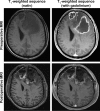The surgical perspective in precision treatment of diffuse gliomas
- PMID: 30863116
- PMCID: PMC6390867
- DOI: 10.2147/OTT.S174316
The surgical perspective in precision treatment of diffuse gliomas
Abstract
Over the last decade, advances in molecular and imaging-based biomarkers have induced a more versatile diagnostic classification and prognostic evaluation of glioma patients. This, in combination with a growing therapeutic armamentarium, enables increasingly individualized, risk-benefit-optimized treatment strategies. This path to precision medicine in glioma patients requires surgical procedures to be reassessed within multidimensional management considerations. This article attempts to integrate the surgical intervention into a dynamic network of versatile diagnostic characterization, prognostic assessment, and multimodal treatment options in the light of the latest 2016 World Health Organization (WHO) classification of diffuse brain tumors, WHO grade II, III, and IV. Special focus is set on surgical aspects such as resectability, extent of resection, and targeted surgical strategies including minimal invasive stereotactic biopsy procedures, convection enhanced delivery, and photodynamic therapy. Moreover, the influence of recent advances in radiomics/radiogenimics on the process of surgical decision-making will be touched.
Keywords: biomarker; cytoreductive surgery; extent of resection; metabolic imaging; molecular markers; personalized medicine; precision medicine; prognosis; stereotactic biopsy.
Conflict of interest statement
Disclosure The authors report no conflicts of interest in this work.
Figures



References
-
- Louis DN, Perry A, Reifenberger G, et al. The 2016 World Health organization classification of tumors of the central nervous system: a summary. Acta Neuropathol. 2016;131(6):803–820. - PubMed
-
- Dunn GP, Andronesi OC, Cahill DP. From genomics to the clinic: biological and translational insights of mutant IDH1/2 in glioma. Neurosurg Focus. 2013;481(2):E2. - PubMed
-
- Weller M, van den Bent M, Tonn JC, et al. European association for neuro-oncology (EANO) guideline on the diagnosis and treatment of adult astrocytic and oligodendroglial gliomas. Lancet Oncol. 2017;18(6):e315–e329. - PubMed
Publication types
LinkOut - more resources
Full Text Sources

